5 Things Art Shows About What Society Values
- Elaine R Kelly
- Sep 28, 2023
- 8 min read
Updated: May 24, 2025
When I visited the Auckland Art Gallery in New Zealand, I reflected on how art shows how society values masculinity and how society's values are shaped by culture and religion. I thought back to how my own society's values are reflected in our art.
1. Unlike the Maori art, our North American art has not historically shown women as political leaders signing contracts,
2. While European art and sculpture often uplift the male body, portrayals of biblical stories often omit women, even though women were likely there.
3. Our art shows how we have honoured masculinity over time. While Jesus has been portrayed as meek and submissive in the past, current portrayals often show him as powerful, strong and fearless. Art and movies often uplift images of muscular men.
4. North American and European art reflects cultural values of heterosexual male strength, while the Maori art honoured women, men, and two-spirit LGBTQ. The homosexual Maori man was seen as having a broader understanding than cisgender folk. The art gave a new perspective on the injustice of shooting arrows at a submissive man.
5. Art also shows the dichotomy in views on marriage, celibacy, and sexual orientation. It shows that the acceptable ideal is not always ideal. The norms of our society can create or aggravate divisions in our society and culture.
1. Art Shows Women's Roles
While historic European art shows women in lower-status roles, Maori art shows chiefly women. Many Maori women were important and had the rank of chiefs. The Treaty of Waitangi, signed in 1840, was the core agreement between the people of Aotearoa-New Zealand and Britain. In Britain at that time, women did not have a vote or a say in important issues. The Church had a strong influence opposing women's leadership. Henry Williams, a man who visited some Maori, allowed women to sign this treaty. Other men visited other villages and refused to allow Maori women to sign. This insult meant their husbands refused to sign.

The Auckland Art Gallery displays a painting of Rangi Topeora by Gottfried Lindauer. It shows a woman who was proud and resourceful, a spirited leader, a talented artist, and a ruthless enemy. She was undeniably a major figure of her time, being one of the women who signed the Treaty of Waitangi in 1840. Her tall feathers indicate her high status. The jade stone necklaces were passed down through the generations and were a sign of social status and power, strength and sacredness.

Pare Watene, painted in 1878 by Gottfried Lindauer, showed a Maori woman famous for her beauty and chiefly status.
She wears rare huia feathers, a jade-stone necklace (pounamu), and holds a short flat jade weapon (mere).
Unfortunately, the translation of the Treaty was inaccurate. The English version of the Treaty gave sovereignty and absolute control of the territory to the British Queen. The Maori version of the Treaty gave governance to Britain, but allowed Maori to set laws about the behaviour and control of the settlers.
2. Art Uplifts the Male Body
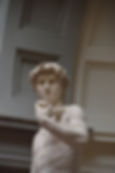
For centuries, male nudity was seen as positive, strong, and virtuous, while female nudity was feared as a source of corruption. The Catholic cathedral of Florence commissioned Michelangelo to carve the marble sculpture of the biblical David, completed in 1504. It portrays David holding the sling he used to kill the giant and shows masculine beauty, independence and strength. To the people of Florence, it symbolized their fight to remain an independent city-state.
In Classical and European art, the male nude stood for strength and moral virtue.
Students learned how to draw the male body, considered the perfect example of a human body. Some biblical interpretations continue to emphasize the male body as good and the female body as sinful.
It was not until the mid-19th century that female models were brought to life-drawing classes, and later women could be students in life art classrooms. The Auckland Free School of Art was an exception, allowing female students from its opening in 1878.

It was interesting to read that historically, they thought only a man could paint a man, and women were considered incapable of drawing the male figure.
I remembered reading that My First Bible in Pictures used an illustration team where the husband illustrated the male figures and his wife illustrated the women and children.
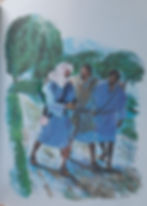
I am not sure what principle would make them think it was inappropriate for a person to draw a person of the opposite sex. Some of the illustrations include both genders, so it seemed that each illustrator did a portion of the illustration. This book stuck in my memory as evidence of my early passion to see women in the Bible. As I read this book to my three daughters, I wanted them to see themselves in the Bible stories. With my apologies to the artist, I changed one of the figures on the Road to Emmaus to look like a woman by covering the facial hair, adding a headscarf and purse, and making the legs thinner. I have since seen that other artists have depicted the road to Emmaus with Clopas and his wife.
3. Art Shows How Society Has Honoured Masculinity
The Auckland Art Gallery was showing a special exhibition exploring Manpower: Myths of Masculinity. This 1905 painting of men on horseback shows the beauty and strength of the male nude, emphasized by their horses.
This image reminds me of the 2023 Barbie movie. In it, the Ken doll discovers a love of horses, and they - especially stallions - are a symbol of elite masculinity, power and control. The Barbie movie is a satire, exaggerating the problems of any one gender having all the power and authority.

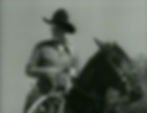
In her book, Jesus and John Wayne
Kristin Kobes Du Mez explores the relationship between evangelical Christianity, militarism, and American masculinity. She identifies the historic support of the church for tough masculinity.
Society and Christianity have honoured traits typically associated with masculinity: strength, courage, independence, leadership, and assertiveness.
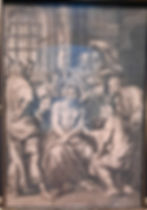
The Mocking of Christ, painted by Francois Langot in 1699, showed Christ displaying effeminate qualities of humility, passivity, acceptance, submissiveness, and forgiveness. Renaissance and Baroque artists often portrayed those who are mocking Christ, displaying what we would today call toxic masculinity.
However, in the 1900s, Christianity focussed on Christ displaying masculine qualities, strength and bravery, rather than passiveness, acceptance, and submission. The Bible shows these traits are neither masculine nor feminine. The fruits of the spirit are not gender specific. Men and women are both called to love, peace, patience, gentleness, kindness, and self-control.
Why did the Church support the display of masculine strength in the early 1900s? The Auckland Art Gallery exhibit noted that the 1895 arrest of Irish literary writer Oscar Wilde for homosexual acts triggered a reaction in society and in art. There was a crisis of masculinity and opposition to any signs of homosexuality or aesthetics. Traditional views blamed same-sex love for depopulation and the weakening of the nation. They thought that luxury and effeminacy brought down great empires. Effeminacy was related to being weak, like a female, or being the passive partner in relationships. Bodybuilding and Rugby were encouraged. The Boy Scout movement was formed to educate and train young boys and prepare them for war. A working man's body was esteemed more than that of a cultivated, gentleman's body. Artists began to depict muscular, masculine males engaging in vigorous physical activity.
4. Art Shows Who Society Honours

Traditional art focused on high-class portraits and religious subjects. During the Romanticism Period, art focused on emotions and moods rather than reason and structure. In the late 1800s, during the Realism period, art focused on ordinary scenes with subjects doing everyday work. Over time, art changed who and what it honoured: the high class or the working man, reason or emotion, the heterosexual or homosexual
Dandy, painted in 2007 by Lisa Reihana is a portrait based on a carved panel in a Maori meeting house. He is shown with his tattoo and dressed in 19th-century clothing, carrying a ceremonial walking stick. His posture asserts his power and preparedness to address the European visitors on behalf of the Maori.
The Maori honoured two-spirit men as having extra knowledge and insight. They sent homosexual men to make first contact with Europeans. They thought men of two spirits might be better able to navigate the negotiations because their experience gave them insight into ways of thinking beyond male and female. I reflected on why the Maori honoured the two-spirit man while the Europeans honoured the heterosexual man.

Saint Sebastian, painted by William A. Sutton in 1951 is a life-size depiction of Saint Sebastian shot with arrows.
Originally the patron saint of archers and athletes, during the bubonic plague (black death) of the 1300s, Saint Sebastian survived many arrows, and he became a symbol of hope. He became a martyr representing homosexuals, with his back being a target for arrows of criticism.
During the HIV/AIDS epidemic of the 1980s, Saint Sebastian came to represent tender male beauty and resilience against plagues. This painting seems to draw empathy for the homosexual in a way that European paintings do not.
This painting encourages the viewer to see a beautiful, flawless male figure being attacked and crucified. Could it be subversively reminding us that Jesus died for homosexuals, too?
5. Art Shows Dichotomy
Art shows the divisions in our society, contrasting our gender norms and making a statement about those who are left behind. In the story of the Lost Sheep, the shepherd leaves ninety-nine sheep to search for the one lost sheep and celebrates finding it. Jesus is a model of the Good Shepherd. As male or female shepherds, we follow Christ, caring for the marginalized.
This last painting I'm sharing from my Auckland Art Gallery visit made me reflect on whether traditional marriage is actually the best way for all people. Some are naturally homosexual, and some are created for celibacy.
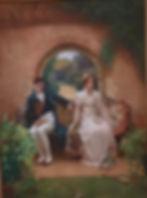
Married, painted in England in 1896 by Walter Dendy Sadler, reveals loneliness within the heteronormative marriage contract. The still shuttlecock (badminton birdie) suggests the man's impotence. His fashionable attire and devotion to reading indicate the effeminacy that was criticized in the Victorian era. This piece shows the futility of homosexuals in a heterosexual marriage. The woman's bouquet is wilting as their love dies. She watches the tortoise move slowly as she slowly realizes that she will never win her husband's attention; their differences are irreconcilable. The Auckland Art Gallery noted beside the painting that New Zealand's marriage laws were reformed in 2013 despite opponents saying the change would diminish the sanctity of marriage.
In conclusion, a look at art from different cultures shows:
Art shows Women's Roles in that culture
Art has traditionally uplifted the male body as the ideal, perfect figure
Art shows how society and Christianity have honoured masculine strength and form
Art shows who society honours
Art shows dichotomy, displaying visually the divisions in our society and culture.
I hope that Society's views of sexual orientation are not irreconcilable. I hope that Christians can imitate Christ, care for each other and especially the marginalized.
Elaine Ricker Kelly Author is empowering women with historical fiction about women in the Bible and early church and Christian blogs about women in leadership, church history and doctrine. Her books include:
Forgotten Followers from Broken to Bold, Book 1, A Novel (2022)
The Sword: A Fun Way to Engage in Healthy Debate on What the Bible Says About a Woman's Role (2023)
Because She Was Called from Broken to Bold, Book 2, A Novel of the Early Church (2024)
Walk with Mara on Her Healing Journey: 21 Steps to Emotional Resilience (2024)
Finding Her Voice from Broken to Bold, Book 3, A Novel of the Earliest Female Apostles (coming October 2025)